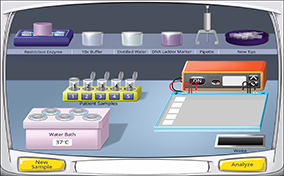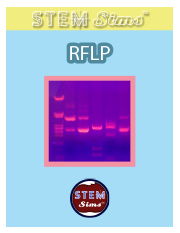What is RFLP?
RFLP stands for restriction fragment length polymorphism. RFLP is a technique used in molecular biology that separates various lengths of DNA fragments through gel electrophoresis. RFLP analysis has applications in genetic fingerprinting, such as solving crimes based on crime scene evidence and paternity testing, and in other genetics testing purposes, such as identifying diseases and disorders.
What is a restriction enzyme?
A restriction enzyme cuts a length of DNA into smaller pieces at a specific point, called the restriction site. A restriction enzyme is also called a restriction endonuclease. The restriction enzyme makes two cuts on the strand of DNA. Each cut occurs at a given point in the sugar-phosphate “side” of the DNA strand. Researchers have identified a wide variety of restriction enzymes, with more than 600 different enzymes currently available for commercial purchase.
What is gel electrophoresis?
Gel electrophoresis is a method for separating various important biological molecules, such as DNA, RNA, and proteins. Electrophoresis separates the molecules based on the length of fragments. The gel allows smaller molecules to travel a greater distance, while larger molecule move a shorter distance. A charge is placed at the opposite end of the gel and molecules move towards the charge based on the molecules’ charge.
How does RFLP work?
The image below shows how the restriction enzyme cuts the DNA at specific points. The DNA fragments then move through the gel different distances depending on their size.
What is a DNA ladder marker?
The function of a DNA ladder marker when used in RFLP analysis is to provide a measurement scale by which DNA fragment movement from the sample can be compared.
What is sickle cell anemia?
Sickle cell anemia is a form of anemia in which the shape of a person’s red blood cells is altered so the cell is unable to effectively carry ample amounts of oxygen to the body cells. The misshaped blood cells also are sticky and often become trapped in small vessels, which in turn blocks normal blood flow to those cells service by the vessels. Sickle cell is an inherited disorder and currently does not have a cure; however, treatments are available to reduce the pain and other problems associated with the disorder. Sickle cell is a recessive trait that must be passed on to the offspring from via a defective gene from both the father and mother.
What is a carrier?
Genetics is the study of heredity in living organisms. In genetics, a dominant trait is one that will appear in an offspring. Two genotypes can produce the dominant trait (phenotype). If red is dominant over white in terms of flower color, both the homozygous dominant (RR) and heterozygous (Rr) will results in flowers displaying the red color. Only the homozygous recessive genotype (rr) will produce white flowers. A carrier of a recessive trait disorder would have the heterozygous genotype (Rr). This individual would not have the disorder, but could pass the disorder onto offspring.
 Increased risk of strokes, organ damage, and a general lack of energy are just a few of the conditions associated with sickle cell anemia. The early detection and treatment of symptoms is critical in reducing the risks of sickle cell. RFLP is one technique used to identify the presence of a sickle cell. Are you ready to determine a patient’s risk of sickle cell anemia?
Increased risk of strokes, organ damage, and a general lack of energy are just a few of the conditions associated with sickle cell anemia. The early detection and treatment of symptoms is critical in reducing the risks of sickle cell. RFLP is one technique used to identify the presence of a sickle cell. Are you ready to determine a patient’s risk of sickle cell anemia?)


